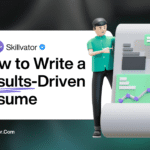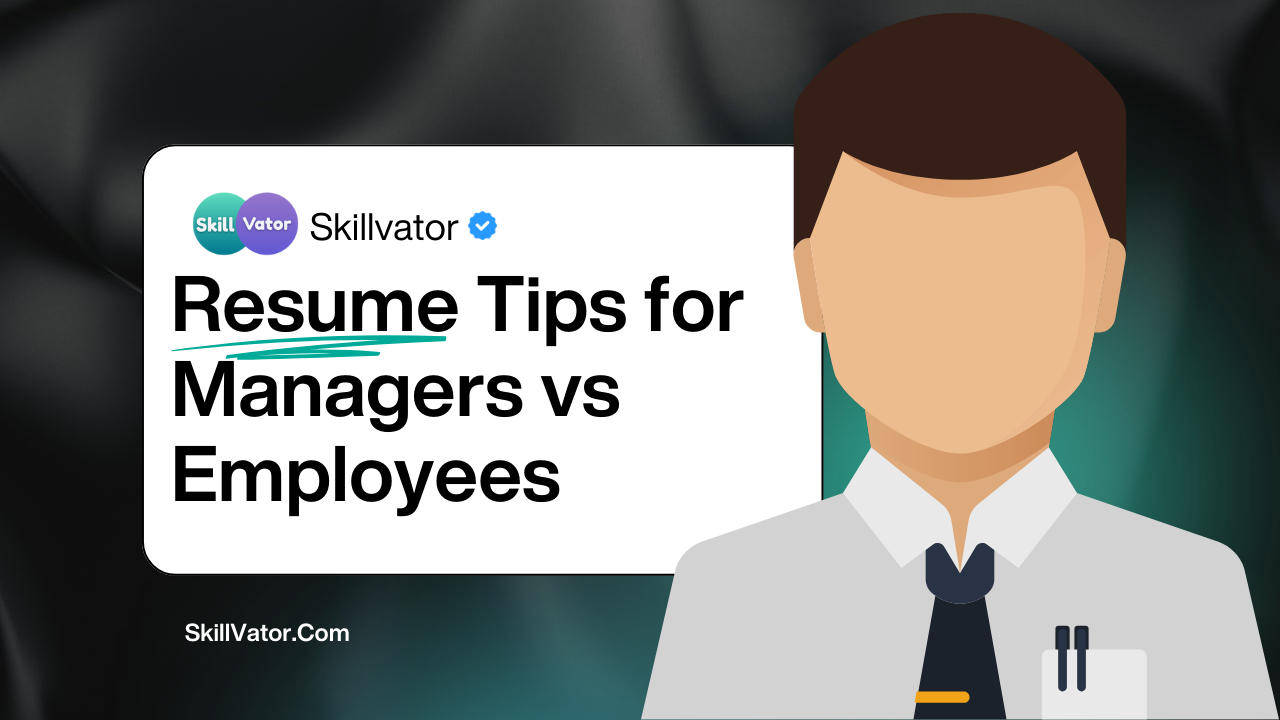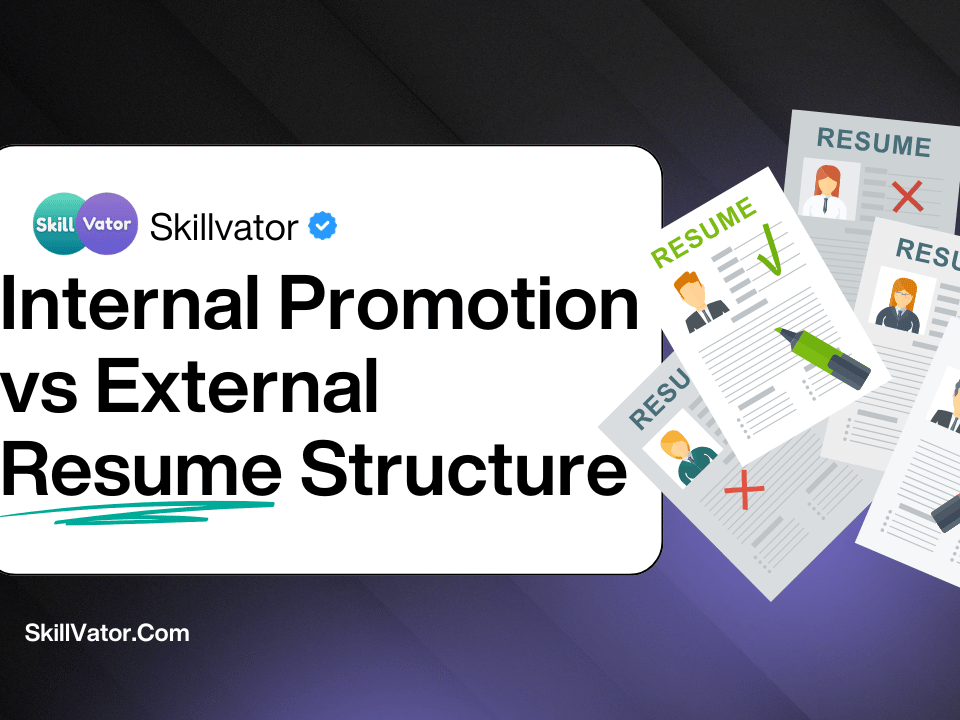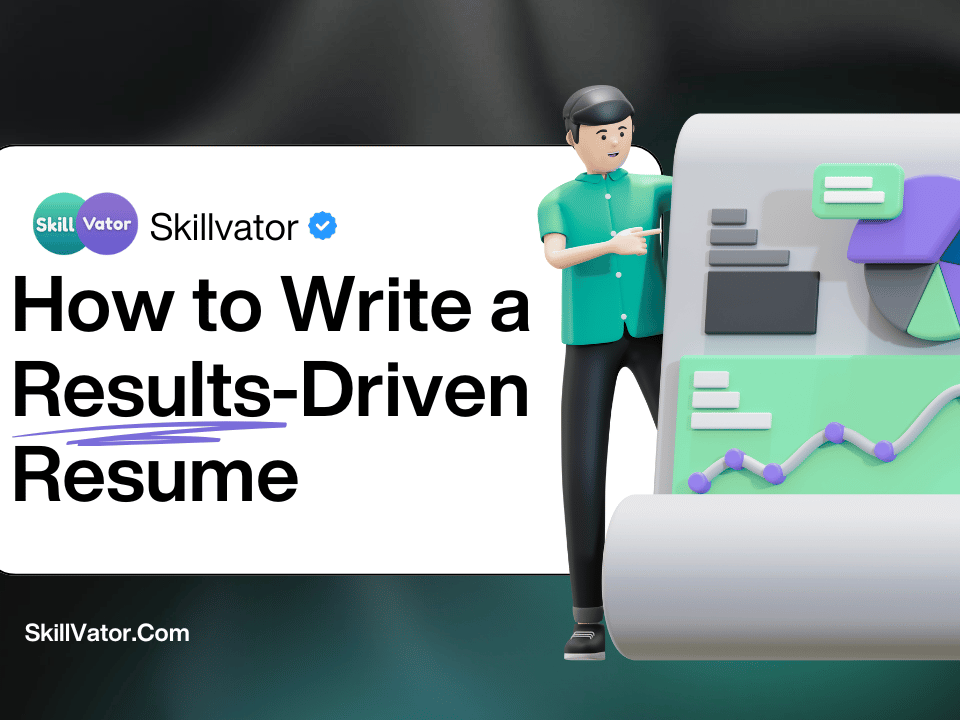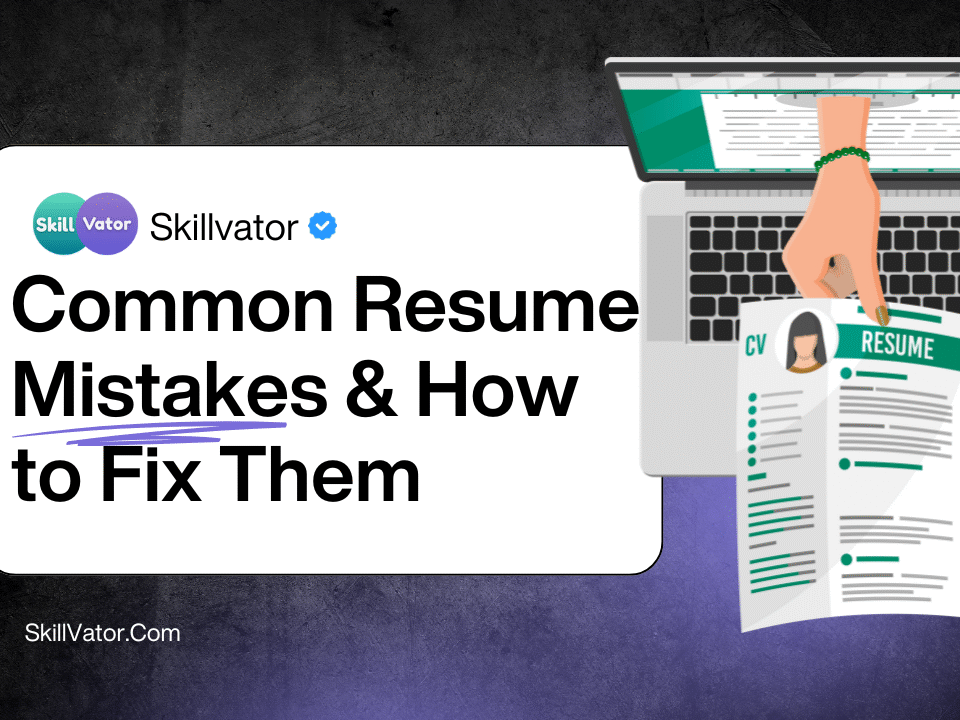When it comes to building a resume, managers and employees can’t play by the same rules. While both need to present themselves as capable professionals, the focus, structure, and content of their resumes differ significantly.
As Raha Heydari, founder of Skillvator and career skills coach, I’ve reviewed thousands of resumes across industries. One thing is clear—what makes a manager’s resume stand out is not the same as what makes an employee’s resume shine.
In this guide, you’ll learn how to tailor your resume based on your career level, avoid common pitfalls, and showcase your achievements in a way that gets noticed, if you need full guide check : Resume Building Guide
Why Resumes Should Differ by Career Level
| Career Level | Primary Resume Focus | Key Elements to Highlight |
|---|---|---|
| Managers | Leadership impact, strategic results, team performance | Leadership achievements, KPIs, budget responsibility, change management |
| Employees | Technical skills, execution results, reliability | Specific skills, productivity metrics, problem-solving, teamwork |
A resume isn’t just a list of jobs — it’s a strategic marketing document. And just like marketing changes for different audiences, your resume should change based on career level. I’ve seen many talented professionals lose opportunities simply because their resumes didn’t match the expectations for their stage in the career journey.
Expectations Evolve with Experience
Hiring managers expect different things from an entry-level candidate, a mid-career professional, and an executive.
-
Entry-Level: Employers look for education, internships, certifications, and transferable skills. The focus is on potential.
-
Mid-Career: Here, hiring managers expect evidence of achievements, process improvements, and contributions to team success.
-
Executive/Manager: The spotlight is on leadership impact, strategic vision, and measurable business results.
The Role of Metrics Changes
While everyone benefits from using numbers, the type of metrics shifts by career level:
-
Employees highlight project completion rates, sales growth, or efficiency gains in their role.
-
Managers emphasize team performance, cost savings, retention rates, and overall departmental achievements.
Formatting Needs Adjusting
A reverse-chronological format works well for employees climbing the ladder, but managers and executives often benefit from a combination format that balances skills with career history.
Keyword Strategy Must Be Career-Specific
Applicant Tracking Systems (ATS) scan for role-specific keywords.
-
Employees should target technical skills and tools.
-
Managers need leadership, strategy, and decision-making keywords.
Ignoring this distinction can result in your resume being filtered out before a human sees it.
Career Narrative Strengthens with Seniority
Early-career resumes can focus on potential and adaptability, while senior-level resumes must present a cohesive career story — how each role has built toward the current leadership position.
Pro Tip from Raha Heydari at Skillvator:
Using a one-size-fits-all resume is like wearing the same suit to a job interview, a casual networking event, and a high-profile board meeting — it just doesn’t fit the context. Tailor your resume to your career stage, and you’ll instantly increase its relevance, impact, and chances of getting noticed.
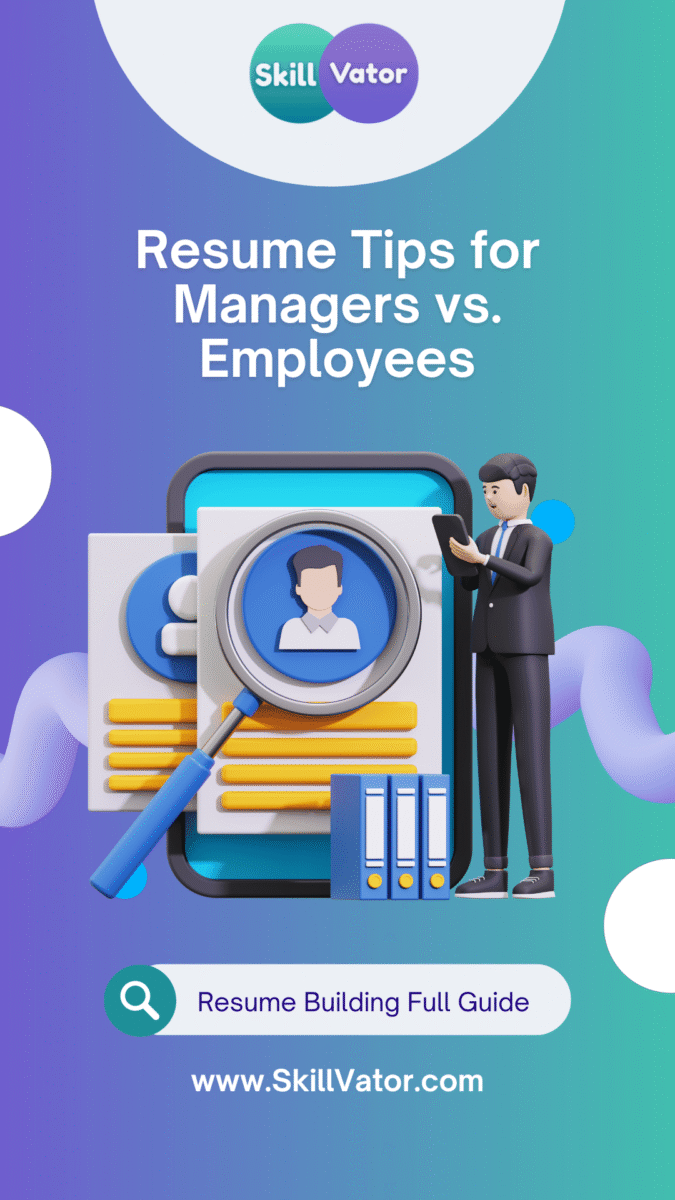
1. Professional Summary: Position Yourself Correctly | Resume tips
-
Managers – Highlight leadership experience, measurable business impact, and strategic achievements. Example:
“Senior Operations Manager with 12 years’ experience leading cross-functional teams, reducing operational costs by 22%, and delivering consistent revenue growth.” -
Employees – Focus on hands-on skills and personal contributions. Example:
“Detail-oriented Administrative Assistant with 5 years of experience managing schedules, improving workflow efficiency by 18%, and providing exceptional client support.”
For more on creating powerful summaries, check out our guide: How to Write a Results-Driven Resume.
2. Work Experience: Results vs Responsibilities
-
Managers should quantify leadership outcomes:
-
Team growth rates
-
Budget managed
-
Process improvements
-
Organizational change initiatives
-
-
Employees should show execution success:
-
Project completion percentages
-
Problem-solving examples
-
Contribution to team goals
-
📌 Related Resource: Common Resume Mistakes and How to Fix Them
3. Skills Section: Soft vs Technical Skills Balance
| Skill Category | Managers – Key Skills to Highlight | Employees – Key Skills to Highlight | Why It Matters |
|---|---|---|---|
| Leadership & People Management | Team leadership, performance coaching, conflict resolution, succession planning | Team collaboration, following leadership direction, peer mentoring | Shows ability to lead or contribute effectively to group success. |
| Strategic Thinking | Long-term planning, change management, market analysis, decision-making | Process improvement suggestions, problem-solving, adapting to change | Demonstrates capacity to drive or support business growth. |
| Communication Skills | Public speaking, executive reporting, stakeholder negotiation | Active listening, clear written communication, customer service | Strong communication impacts productivity and workplace harmony. |
| Project Management | Budget oversight, multi-department coordination, resource allocation | Task prioritization, meeting deadlines, reporting progress | Ensures projects are delivered efficiently and effectively. |
| Technical Skills | Industry software (ERP, CRM), data analytics tools, budgeting platforms | Role-specific tools, Microsoft Office Suite, scheduling software | Reflects ability to perform role-specific duties accurately. |
| Analytical Skills | KPI analysis, risk assessment, market trend evaluation | Data entry accuracy, error spotting, quality control | Critical for problem-solving and decision-making. |
| Soft Skills | Negotiation, empathy, cultural awareness, resilience | Adaptability, attention to detail, reliability, work ethic | Builds trust and supports team and organizational culture. |
4. Achievements: Strategic vs Task-Oriented
Managers should focus on big-picture wins:
-
“Led a team of 25, increasing productivity by 35% in 12 months.”
-
“Oversaw $2M budget with 8% cost savings year-over-year.”
Employees should focus on execution milestones:
-
“Processed 150+ client requests per week with 98% satisfaction rate.”
-
“Implemented filing system that reduced retrieval time by 40%.”
5. Resume Format Choices
-
Managers – Consider a combination resume format to highlight both skills and achievements prominently.
-
Employees – A reverse chronological format works best to showcase career progression clearly.
More details: Best Resume Formats for Different Job Roles

People Also Ask – Resume Tips for Managers vs Employees
How should a manager’s resume differ from an employee’s resume?
A manager’s resume should highlight leadership achievements, team performance metrics, and strategic impact. An employee’s resume should focus on technical skills, task execution, and measurable contributions to projects. Both must use job-specific keywords for ATS optimization.
What soft skills are most important for managers to include?
Managers should list leadership, conflict resolution, decision-making, and negotiation skills. These show the ability to lead teams, solve complex challenges, and deliver organizational results.
How can employees show leadership potential on a resume?
Employees can highlight moments where they took initiative—such as training peers, solving problems, or improving processes. Using results-based bullet points makes these contributions more impactful.
Should managers use a different resume format than employees?
Yes. Managers benefit from a combination resume format that emphasizes both skills and results. Employees usually do best with a reverse chronological format to show career progression clearly.
What metrics should managers include on their resumes?
Metrics such as revenue growth percentages, cost savings, employee retention rates, and project delivery timelines are powerful proof of managerial success.
How do employees avoid looking too junior on a resume?
By emphasizing accomplishments, quantifiable results, and transferable skills, employees can project readiness for greater responsibility.
Do both managers and employees need to tailor their resumes for each job application?
Absolutely. Customizing your resume for each role increases relevance, improves ATS match scores, and makes your application stand out to recruiters.
What is the most common resume mistake for managers vs employees?
Managers often make the mistake of listing duties without impact metrics. Employees often underplay their achievements by not quantifying results.
Final Takeaway from Raha Heydari at Skillvator
Your resume should tell the right story for your career stage. Managers must demonstrate leadership and strategic vision, while employees need to showcase skills, results, and reliability. When tailored correctly, your resume doesn’t just list what you’ve done—it proves what you can achieve next.
For more career skill-building resources, visit Skillvator and explore guides designed to help you secure the right opportunities faster.

